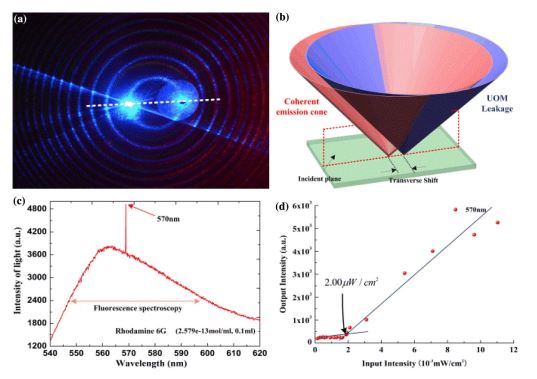
Time:2018-02-26 Read:1890
Our research team’s Hailang Dai doctor report an ultralow-threshold continuous-wave lasing via a metallic optofluidic resonant cavity based on the symmetrical metal-cladding waveguide. The high quality factor Q and spontaneous emission coupling factor β of the waveguide strengthen the interaction between the gain medium and the ultrahigh order modes (UOMs); hence, the roomtemperature, narrowband lasing can be effectively pumped by a continuous laser of low intensity. Rhodamine 6G and methylene blue are chosen to verify the applicability of the proposed concept. Lasing is emitted from the chip surface when the pumped laser is well coupled into the UOMs. For methylene blue with a concentration of 2.57*10-13 mol∕ml, the operated emission can be observed with the launched pump threshold as low as 2.1 μW∕cm2.
Different from the usual strategy of using microcavity or nanocavity structure, a novel low-threshold dye lasing based on a millimeter scale resonant cavity was proposed. Taking advantage of the high Q and β value of the SMCW structure, the experimental threshold was significantly reduced; a continuous laser pump and active solution of extremely low concentration are sufficient at room temperature. The coherent light emission results in a series of concentric lasing cones, which is similar to the leakage radiation of the UOMs. The output cones undergo a transverse shift to the UOM leakage cones. In addition to an easy fabrication process, effective modulation can be achieved by adjusting the coupling efficiency of UOMs. Given the attributes mentioned above, our “macroscale” optofluidic resonant cavity structure may open up new prospects for many fields such as optofluidics and biosensors.

Publication:
Hailang Dai, Bei Jiang, Cheng Yin, Zhuangqi Cao, and Xianfeng Chen, Ultralow-threshold continuous-wave lasing assisted by a metallic optofluidic cavity exploiting continuous pump, Optics Letters, 43(4), 847-850 (2018)